Bushell | Albert Victor
- First names
Albert Victor
- Age
21
- Date of birth
21-12-1922
- Date of death
15-10-1944
- Service number
6215937
- Rank
Rifleman
- Regiment
Royal Ulster Rifles, 2nd Bn.
- Grave number
IV. D. 10.
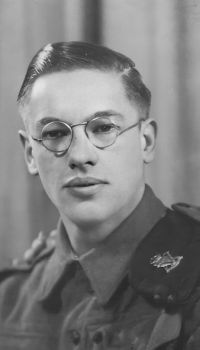
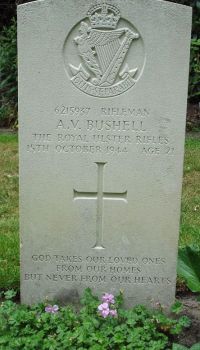
Biography
Albert Victor Bushell was killed in action on 15 October 1944 in the vicinity of Overloon. He was aged 21 at the time. He was a Rifleman in the 2nd Battalion of the Royal Ulster Rifles (Service No. 6215937). He was initially buried at Cemetery Helderse Bossen, Overloon and re-interred on 29 May 1947 in grave IV. D. 10. in the Overloon CWGC Cemetery. The inscription on his grave reads “God takes our loved ones from our homes but never from our hearts.”
Military Career
It isn’t known when Albert (who was known as Vic) joined the 2nd Battalion of the Royal Ulster Rifles, but given his age, it is likely to have been around 1940.
The battalion took part in the D-Day landings in June 1944 and fought in the Battle of Normandy, specifically in Operation Charnwood where they were the first British troops to enter the city of Caen, which had previously seen bitter fighting in the British attempt to capture it.
From mid July until mid September they remained in France, alternating between spells of fighting and spells of rest and training.
On 16 September they made the long journey from their last base in France at Hacqueville to Naast near Soignes in Belgium. The War Diary states that “from Albert to Mons people lined the streets of the towns giving us a very warm welcome and presented us with fruit. In some places the crowds which congregated made it rather difficult for the convoy to get through”. They moved on a further 112 miles the following day to Kolis near Lille St Hubert. Again “cheering crowds welcomed us in every town and village, presenting us with coffee and more fruit.”
On 18 and 19 September the Battalion was involved in extending and solidifying the bridgehead over the Escaut Canal which had already been made by 50 Division.
On 21 September, they crossed from Belgium into the Netherlands at Maarheeze, where they rested until the 24th before moving on to Deurne on the 15th, Bakel on the 29th, Beers on 1 October and then Cuijk on 2 October. They remained in the vicinity of Cuijk until 11 October, experiencing some shelling but also undertaking training and relaxation. The War Diary reports that “The Battalion football team played a local Eleven at Beers, our team gaining an easy victory by 5 goals to 1. The game was watched by a large number of spectators & the Band was loudly applauded when they played during the interval & after the game.”
Read here the detailed story about 8 october 1944, the day of the match, told after the war by the son of Sergeant Reginald Hammersley who played along and survived the war himself.
On 12 October, the Battalion moved about 10 miles south of Cuijk to near St Anthonis. It was decided that the 3rd British Infantry Division, of which the Battalion was a part, would clear the area of woody country as far as Venray and possibly further. The role of the Battalion was to lead the Brigade with the intention of capturing & clearing the large wood to the south west of Overloon. The following day they therefore marched from St Anthonis southwards and the initiative started at 0900 hrs. They had a few casualties crossing the open ground but had more cover once in the wood. However, the wood presented its own problems as it varied in thickness, tracks through it were soft and sandy and the tracks and woods on the map bore little relation to tracks and woods on the ground. Most of the enemy had, however, left the wood and they reached their intended position by 1800 hrs. Tanks had been unable to help as they could not follow the infantry through the wood. Indeed, no vehicles could reach the forward companies because tracks had not been cleared of mines so food, water, blankets and greatcoats had to manhandled up to the company positions by relays of working parties. They also had to dig in – so little sleep was had that night. Casualties during the day had not been heavy and these few were caused principally by mortar fire.
On 14 October, the Battalion stayed in position while the 2 Lincolns passed through and carried out an attack on woods 500yds to the south. Much of the day was spent pulling sand trucks out of the sand which had been bogged on the move of the previous evening. The forward Companies were able to return in small numbers at a time to the furthest point that the transport could reach which saved manhandling the food forward.
Under cover of darkness that night A and C Companies moved down the wood to assist the Lincolns in holding it during the night and the following day. Unfortunately, just as A coy were entering this wood a dead salvo from a Nebelwerfer landed right amongst them. It killed 2 men and wounded 10 more.
The Battalion remained in the same positions the following day, 15 October, until after dark. All Companies’ positions were shelled and mortared during the day. After dark Battalion HQ and the remaining Companies moved down to positions in the Lincolns’ wood and dug in for the night.
An account in a book (The Rifles are There) about the Regiment states the following:
“Bushell, Albert Victor, Rifleman, No. 6215937
Served in D and later Headquarters Company, he was mortally wounded by shrapnel to the back on 14/15 October 1944 at Overloon. He was the son of Albert and Daisy Bushell of Harlesden, Middlesex. Buried in Overloon War Cemetery, grave IV. D. 10, he was 21 years old.”
A report in the Marylebone Mercury of 2 December 1944 reported his death as follows:
“Rifleman Albert Victor Bushell, eldest son of Mr & Mrs A Bushell of 85 Tubbs Road, Harlesden, has been killed in action in Holland. Rifleman Bushell who was 21 was a stretcher bearer attached to a famous infantry regiment”.
Family Background
Albert Victor Bushell (Vic) was the son of Albert Bushell and Daisy Jones who had married in Willesden in 1921.
Vic’s father, Albert Bushell, was the son of Albert Bushell and Matilda Hounsham who had married in Hartley Witney, Hampshire in 1881. Albert and Matilda had both been born in Crondall, Hampshire, Albert in 1857 and Matilda in 1856. They had seven children between 1883 and 1897, all in Farnham in Surrey. Of these, Albert (Jnr.) was the second youngest, born on 26/1/1894. It seems that their eldest child, Mary, lived with Albert’s parents in Dippenhall Street, Crondall.
From at least 1891 to at least 1921 Albert and Matilda lived at Dippenhall, Burles Bridge, Farnham, Surrey. Albert was a Farm Labourer. In 1891 their first four children except Mary were with them. In 1901 all but Mary and one other were at home. The eldest boy was working as a Journeyman Baker. By 1911 only two of their sons were still at home, one working as a Farm Labourer and the other as a Poultry Boy. Albert (Jnr.) was now living as a boarder at 145 Railway Cottage, Acton, Middlesex in the household of James and Mary Sherrington and their family. Mary Sherrington was born in Crondall where Albert’s parents had been born so may have been a relative or a friend of the family. Albert (Jnr.) was working as an Engine Cleaner. James Sherrington was a Railway Guard at St Pancras Station. By 1921 Albert’s parents were living on their own, still in Burles Bridge. By 1939 Matilda was widowed and was living at 6 Trimmers Alms Houses, West Street, Farnham, Surrey.
Vic’s mother, Daisy Jane Jones, is thought to have been the daughter of William George Jones and Alice Elliot who married in 1884 in Wandsworth, London. William had been born in 1860/1 in the Paddington district and Alice in 1867/8 in the Putney district. They appear to have had around 12 children between 1886 and 1908, though one died in infancy in 1891 and another in 1901. Most were born in Kensington, though the first was born in Chelsea, the second in Paddington and the last two in the Hendon district in 1906 and 1908. Daisy herself was born on 25/2/1896.
In 1891 William and Alice were living at 12, Treverton Street, Kensington with their first three children. William was working as a Painter’s Labourer. By 1901 they were living at 21, Rackham Street, Kensington with their eight surviving children born by then, including Daisy. William was now a House Painter and their eldest boy was a Sheet Repairer. By 1911 they had moved to 62 Carlyle Avenue, Willesden, but William was not present. All but their eldest son was still at home. Daisy was working as a Brass Finisher and Packer while her eldest sister was working at an Electric Lamp Works. The second eldest boy was working in Photographic Enlarging and the third eldest was a Milk Boy. A 24 year old male boarder was also present, working as a Locomotive Engine Fireman. By 1921 Alice had died and William was a widower. The family were at a similar address in 1921 – 94, Carlyle Avenue. William was working as a Photographic Paper Emulsion Maker for Illingworth, Photo Materials Makers. Only five of the children were now at home, generally the younger ones. One boy was working for the same company as his father as a Spooler of Photo Paper and another was working as a Farm Labourer for H. Brazier, Dairyman. A 20 year old daughter was looking after the home while a 15 year old daughter was working as a Laundry Worker for the White Heather Laundry in Stonebridge.
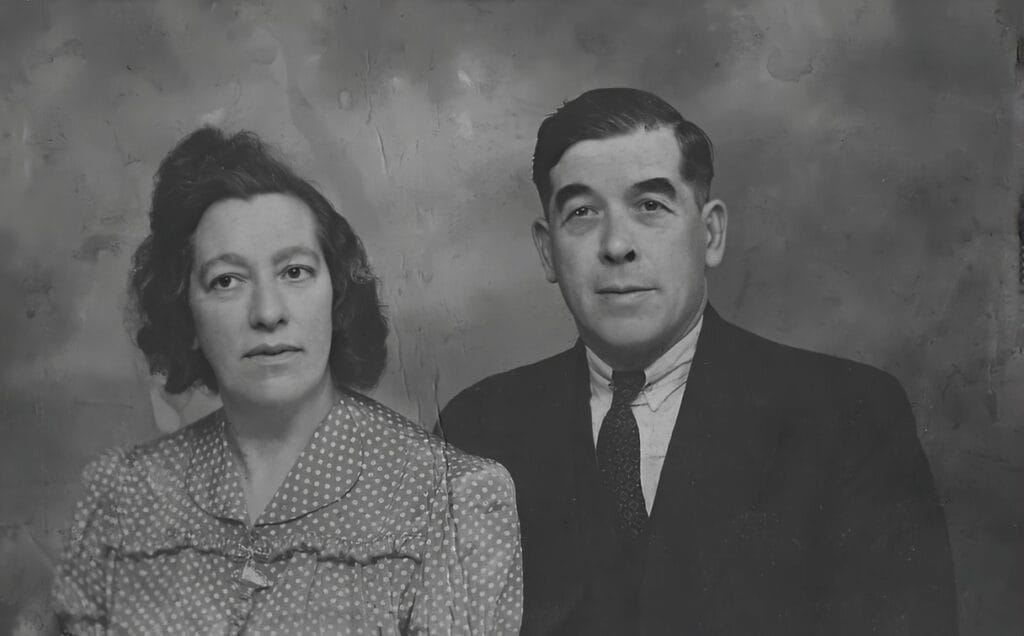
Daisy Jones married Albert Bushell in early 1921. They had four children as follows, all in Willesden: Albert Victor (Vic) born 21/12/1922, Rodney Dennis (known as Dennis) born June1926, Sheila Mary born April 1929 and Dorothy in November 1936.
In June 1921 Albert and Daisy were living as boarders in the household of Frederick and Florence Williams and their family at 51 Bruce Road Harlesden, Willesden. Albert was working as a Locomotive Fireman for the London and North West Railway – and so was Frederick Williams.
By September 1939 Albert and Daisy were in their own household at 85 Tubbs Road, Harlesden. Vic and Dorothy were present as was a lodger, a single man called Charles Fletcher who was a Wood Machinist aged 21. Albert was now employed as a Railway Locomotive Driver and Vic was a Factory Despatch and Loader. Shortly after war broke out, Dennis and Sheila were evacuated to Crondall to stay with their Aunt Mary, their father’s sister who had been widowed twice. Being only two, Dorothy remained at home in Harlesden. However, Dennis threatened to run away, so as soon as London was deemed safe enough, they returned home.
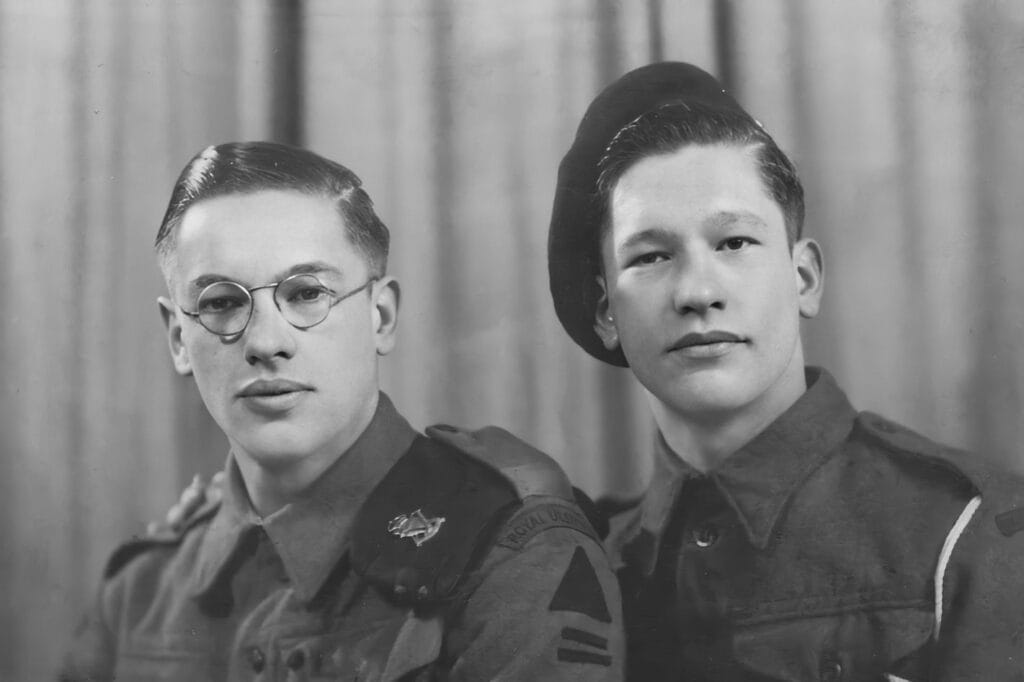
When the Blitz started Sheila and Dorothy were both evacuated to Crondall where they stayed for over two years. By this time Dennis had enlisted (early) in the Royal Marines and spent his 18th birthday on a boat waiting to cross to France for the D Day landings. Dennis thankfully survived the war.
Sadly, Vic was killed in action on 15/10/1944.
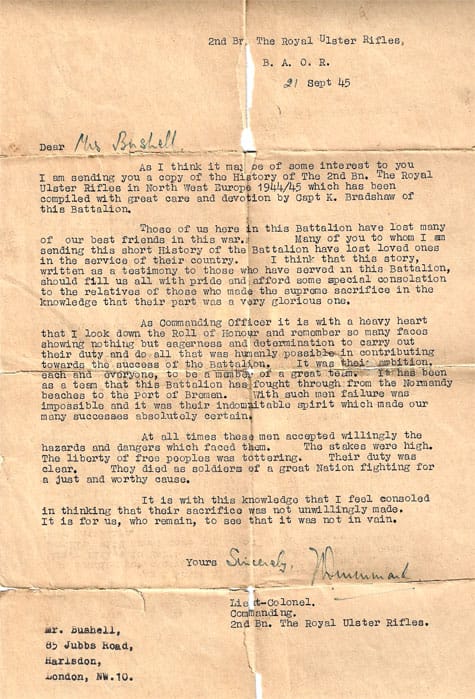
On 21/9/1945 the Lieutenant Colonel of the 2nd Battalion, The Royal Ulster Rifles wrote to Vic’s parents and enclosed a book entitled “The History of the 2nd Bn. The Royal Ulster Rifles in North West Europe 1944/45” which had been written by Captain K. Bradshaw of the Battalion. He commented on how those in the Battalion had lost many of their best friends in the war. He mentioned how the Battalion had fought as a team through from Normandy to the Port of Bremen.
He concludes by saying:
“At all times these men accepted willingly the hazards and dangers which faced them. The stakes were high. The liberty of free peoples was tottering. Their duty was clear. They died as soldiers of a great Nation fighting for a just and worthy cause.
It was with this knowledge that I feel consoled in thinking that their sacrifice was not unwillingly made. It is for us, who remain, to see that it was not in vain.”
During the war, Vic’s father, Albert, had worked as a fire spotter at Willesden Junction. After retiring from the railway he worked as a porter at Central Middlesex Hospital and sadly died waiting at a bus stop outside the hospital on his way home in 1962. Daisy died at home, 85 Tubbs Road, Harlesden, in 1974.
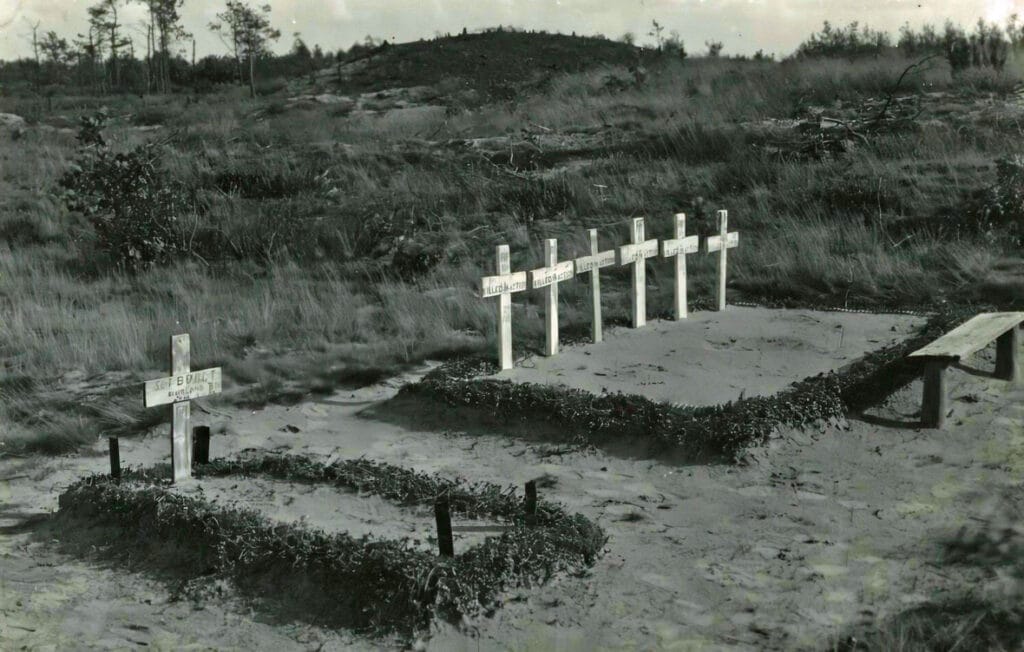
Origin photo unknown
Sources and credits
From FindMyPast website: Civil and Parish Birth, Marriage and Death Records; England Census and 1939 Register Records; Electoral Rolls; Military Records; British Newspaper Archive
Wikipedia 2nd Bn Royal Ulster Rifles
Traces of War – 2nd Bn Royal Ulster Rifles War Diary
2nd Battalion Royal Ulster Rifles in WW2: (royal-ulster-rifles-ww2.blogspot.com)
The Rifles Are There: 1st & 2nd Battalions The Royal Ulster Rifles in the Second World War
by David Orr (Author), David Truesdale (Author), C.W.B Purdon (Contributor)
Marylebone Mercury 02 December 1944
Photos and assistance from Janice Barnard, Vic’s Niece
Research Elaine Gathercole
